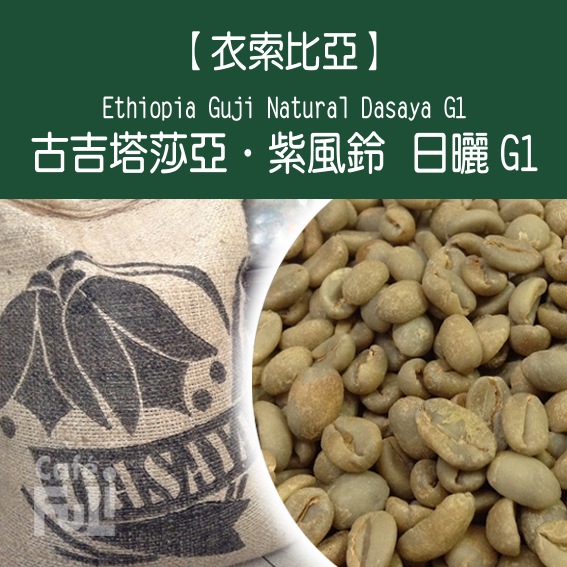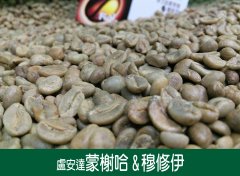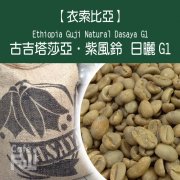Description of flavor and aroma of Ethiopian sun ancient Gitasaya / purple Fengling G1 coffee

For professional baristas, please follow the coffee workshop (Wechat official account cafe_style)
Sobiya sunburn Guji Tasha purple wind chimes G1
Ethiopia Guji Natural Dasaya G1
Country Ethiopia (Ethiopia)
Producing area Oromia Region
Guji (Guji Zone)
Shaquiso (Shakisso Woreda)
1900-2100 meters above sea level
Variety Ethiopia Guyou Variety (Heirloom)
The annual rainfall is about 1500-2000 mm
Treatment method African scaffolding sun treatment
* short comments on Cup Test:
Dry aroma is a strong aroma of berries and wine, with strong strawberry and blueberry aromas accompanied by violets at the beginning, passion fruit, peach and grape juice in the middle and back, and a cool lavender finish. Smooth taste and full juicy flavor is recommended.
The original text of Dasaya in Ethiopia is Dawala Samayawi, which means purple wind chimes! Beans, like its name, are constantly reminiscent of purple and blue fruits, full of pink and purple sweet bubbles. The rich, sweet aromas of blueberries, grapes and other fruits are juicy, the flowers of violets are intoxicating, and the cool wind chimes with lavender aromas at the end add freshness to this ebullient sun work.
Brief introduction of Origin:
The administrative region of Ethiopia is divided into four grades, the order from big to small is Region, Zone, woreda, kebele. Most of the raw coffee beans are named according to this rule. Guji-Shaquiso, which is located in the southeast of the well-known producing area of Yega Xuefei, belongs to Oromia Region → Guji Zone → Shakisso woreda and belongs to the regional source of coffee beans.
Just as Yejasuffe became well-known after it became famous, it became an independent producing area. Guji became an independent production area by ECX in 2010 because of its superior geographical location and cup flavor. Shaquiso is the most attractive micro-producing area in the Guji producing area, which is located in the southeast of Yega Snow Coffee, with an average elevation of more than 1800 meters. The fertile black soil has a significant temperature difference between day and night, so that the local has the conditions to produce high-quality coffee. The sources of local coffee production are almost in the form of individual small farmers. At the beginning of the production season, the ripe red berries nearby are picked and sent to the treatment plant, and well-ventilated African scaffolding is placed to control the temperature and fermentation degree. After the pulp is removed, the water content is reduced to between 11.5% and 12%. When the post-processing and static operation are completed, the export is done through the competitive bidding system of the ECX Ethiopia Commodity Exchange. Local exporters or international buyers then follow this system to compete to find favorite coffee raw beans.
In recent years, the most popular producing area in Ethiopia is Yega Schiffe. Guji-Shakiso is less well-known than Yejia Soga. However, under the trend of soaring overall price of Yega Snow in 2015, international boutique buyers have turned to other neighboring producing areas, such as Sidamo, Limu, Jimma … Wait, wait,
Guji-Shaquiso coffee is actually quite unique, and the coffee produced has also repeatedly attracted market attention. Ninty Plus launched the legendary bean Nekisse at the end of 2009, which originally means "nectar from Shaquiso" (Nectar from Shakisso). The origin and naming come from Shakisso. Another Level Up-produced Derar Ela, which is also produced in Shaquiso, was repeatedly praised by Taiwan businessmen last year, and won an excellent score of 95 Coffee Review points in April 2014.
Important Notice :
前街咖啡 FrontStreet Coffee has moved to new addredd:
FrontStreet Coffee Address: 315,Donghua East Road,GuangZhou
Tel:020 38364473
- Prev

The flavor and taste of sunburn bourbon coffee in batches from Monseha & Mushoi processing plant in the western province of Rwanda
For the exchange of professional baristas, please follow the coffee workshop (Wechat official account cafe_style) Montchamps Hamuyi processing Plant in the western province of Rwanda to work together to batch the sunburn bourbon species Rwanda West Province Mashesha CWS Bourbon Natural countries: Rwanda Rwanda production area: the western province West Province processing plant: Monseha processing plant Mashesha CWS,
- Next

Description of flavor and flavor of Ethiopian washed Yega Coffee Cochel G1 Coffee
For professional baristas, please follow the coffee workshop (Wechat official account cafe_style) Ethiopia Washed Yirgacheffe Kochere G1 Ethiopia washed Yega Chefe Cochelle G1 * A small town of about 20, 000 people, adjacent to three small producing areas Wenago, Kochere and Gelena Abaya, because of the flavor of the coffee.
Related
- Detailed explanation of Jadeite planting Land in Panamanian Jadeite Manor introduction to the grading system of Jadeite competitive bidding, Red bid, Green bid and Rose Summer
- Story of Coffee planting in Brenka region of Costa Rica Stonehenge Manor anaerobic heavy honey treatment of flavor mouth
- What's on the barrel of Blue Mountain Coffee beans?
- Can American coffee also pull flowers? How to use hot American style to pull out a good-looking pattern?
- Can you make a cold extract with coffee beans? What is the right proportion for cold-extracted coffee formula?
- Indonesian PWN Gold Mandrine Coffee Origin Features Flavor How to Chong? Mandolin coffee is American.
- A brief introduction to the flavor characteristics of Brazilian yellow bourbon coffee beans
- What is the effect of different water quality on the flavor of cold-extracted coffee? What kind of water is best for brewing coffee?
- Why do you think of Rose Summer whenever you mention Panamanian coffee?
- Introduction to the characteristics of authentic blue mountain coffee bean producing areas? What is the CIB Coffee Authority in Jamaica?

